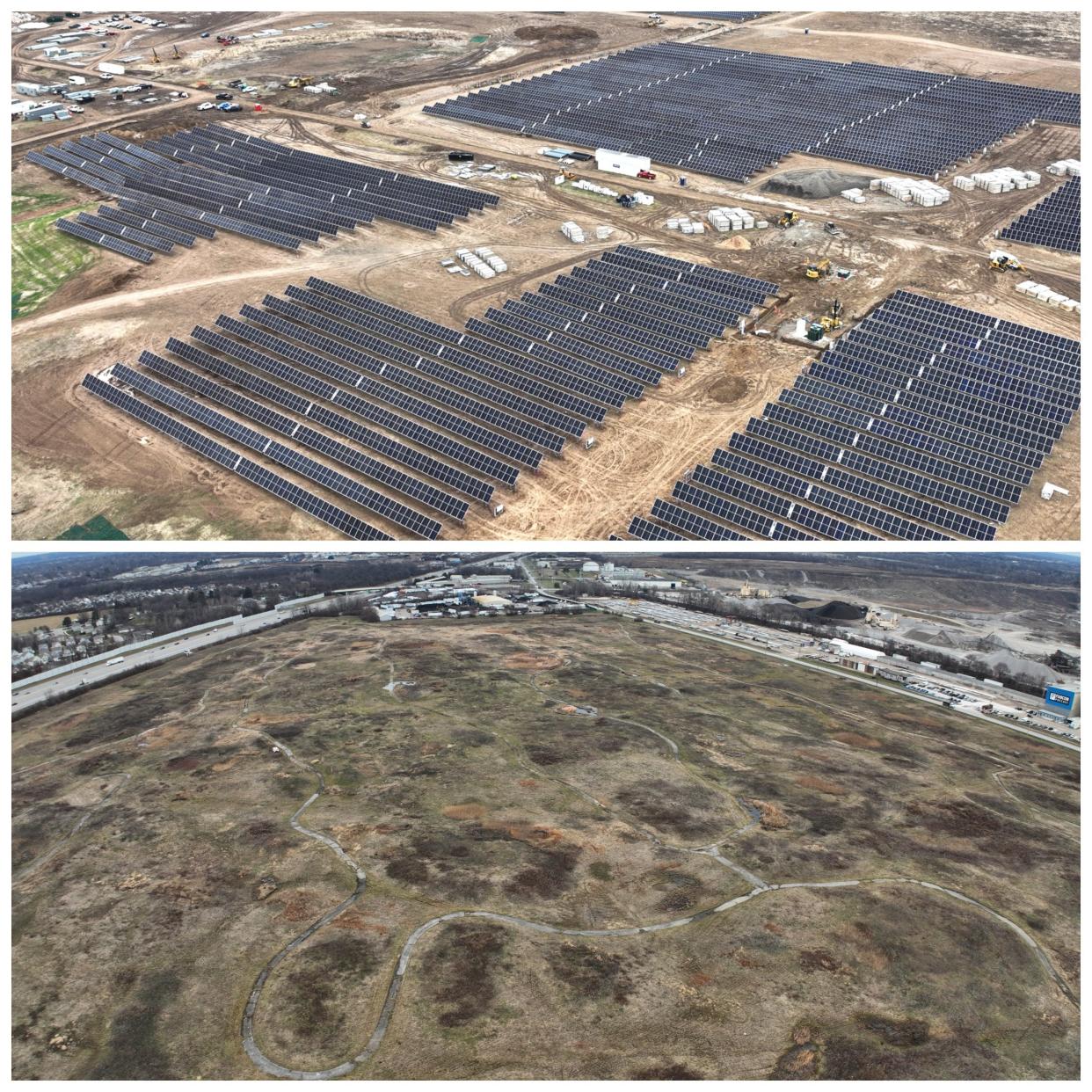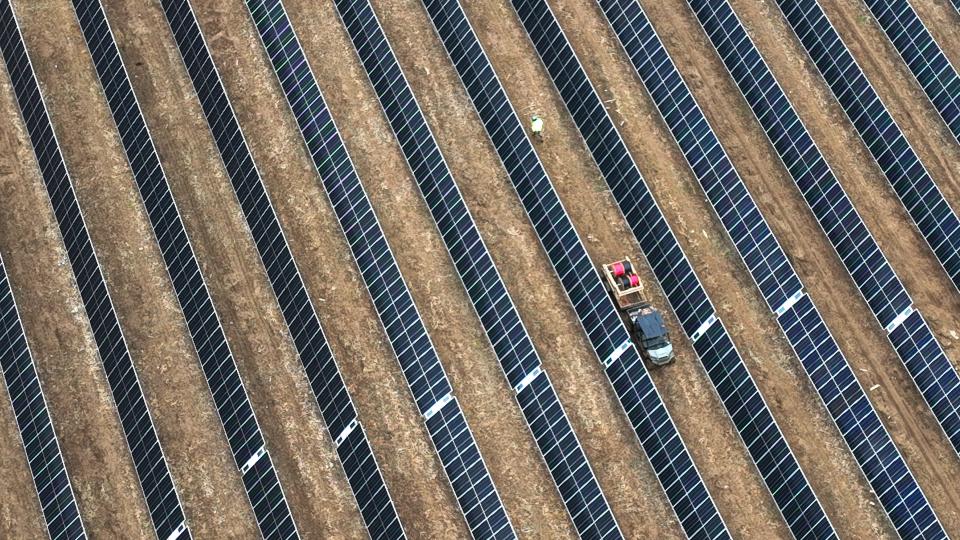Where's the $1 billion in promised Ohio-based solar, wind? Columbus program years behind

New green-generation investments in wind and solar farms to supply most Columbus residents' "municipal aggregation" electricity needs are not only being delayed by up to a decade, but the centerpiece local project also appears to have quietly gone off track.
A massive solar farm atop a closed public landfill on the city's South Side shows no signs of construction — a year after it was scheduled to open. And despite announcing 100% of its power would go to city of Columbus residents, a new city contract raises questions about whether that will happen.
Columbus Mayor Andrew J. Ginther's administration and AEP Energy, a wholly owned subsidiary of Columbus-based utility AEP, revealed at a City Council meeting in early December that three years into a voter-approved city electric aggregation program, none of the promised $1 billion in new Ohio-based solar and wind farms had been completed, and their completion could be many years away.
The green energy goal was being lowered and the timeline pushed back, city officials said, because of COVID-19, the war in Ukraine, new regulations, inflation, and other issues that have challenged renewable-energy development.
More than 180,000 mostly residential Columbus customers as well as small businesses were automatically enrolled into the new green energy program in 2021, switching the electric supplier for a massive 1.7 terawatts annually from AEP's regulated-rate plan to the AEP city aggregation plan billed as "100% Ohio-based clean energy."
Voters approved the switch in November 2020, after AEP Energy funded that campaign with a $1.5 million donation. But the "local" wind and solar farms promised voters by spring of this year have failed to show up.
Going 'green' through renewable energy credits
Now, under an amended draft contract reviewed by The Dispatch, up to 40% of the Ohio-based green generation facilities that AEP Energy pledged to construct would be replaced by power generated out of state and arriving as late as 2034, when the long-term contract between the city and AEP Energy expires. The contract is expected to be approved by the city in the coming months.
Until then, AEP Energy puts the "green" in the aggregation program by purchasing "Renewable Energy Certificates," or RECs. Distinct from actually purchasing the generated power from solar and wind farms, a REC is a certificate authenticating that one megawatt-hour of electricity was pumped into the grid somewhere in the nation. They can be kept by green producers, or sold as a supplemental income source in addition to selling the actual electricity.
The Dispatch reported in May that the RECs used in the program represent wind power generated in Illinois (20%), Nebraska (17%), and Oklahoma (57%), and hydropower in North Carolina (6%) to match the city of Columbus' electric load. The first year, the "green" in the program also came from a steel mill near Chicago that captured waste heat from its smokestacks and turned it into electricity.
An internal rate document shows that what it costs the program to purchase enough RECs from those far-off facilities to claim its 100% green energy designation represents about 80 cents a month on a typical household's $72 energy bill, or 1%. The actual "energy costs" make up about three quarters of monthly bills, and can be met by any source. AEP still produces more than two-thirds of its electricity from coal-fired and natural gas-fired plants.
Columbus Solar Park in doubt
There was one planned Columbus solar farm that couldn't have been more "local," being located inside the I-270 beltway.
But the new draft contract language also casts a major cloud over what officials already publicly billed as a done deal: the much-publicized "Columbus Solar Park." The proposed 50-megawatt solar farm was to be constructed at a cost of $60 million on a 173-acre site on the South Side, east of Interstate 71, that was a former Solid Waste Authority of Central Ohio (SWACO) landfill.
SWACO announced in summer 2020 that it had signed a deal with BQ Energy to build Columbus Solar Park, and AEP announced in fall 2020 that it was finalizing a deal to purchase 100% of the solar farm's power, keeping it for city residents' use through the city aggregation program.

Ginther held a press conference at the landfill in September 2021 to say all of the power from the solar park — enough to supply more than 5,000 homes a year — had been purchased entirely by AEP Energy to supply the city aggregation program through December 2028. Starting in 2029, AEP Energy and the city's municipal utility would then split the generation, Ginther said.
"We’re delivering on the promise to provide local, Ohio-based clean energy," Ginther said at the event.
But the new draft aggregation contract between the city and AEP Energy contains new language stating that "AEP Energy shall be under no obligation to sign any (agreement) related to the Columbus Solar Park Solar Facility" unless all terms and conditions are "otherwise acceptable to AEP Energy." AEP Energy must notify the city in writing if BQ Energy Development "does not meet such requirements," at which point the parties must enter good-faith negotiations "to determine whether the parties are willing and able to preserve or renegotiate" the draft agreement says.
"The original plan for Columbus Solar Park previously announced is still in place, however timelines have shifted due to supply chain and inflationary pressures, COVID-related delays and many of the issues previously discussed that are impacting many clean energy developments," Erin Beck, an assistant director with Ginther's Department of Public Utilities, said in an email in late December when asked about the new contract provision.
"All parties are committed to the success of the Columbus Solar Park. and utilizing the clean energy generated to support clean energy for Columbus residents."
The new solar park was stalled by regulatory and supply-chain issues, SWACO spokesperson Hanna Greer-Brown said in May, adding that SWACO was "optimistic that we’ll begin to see more active construction at the site in the coming months," which would take about a year to complete once work began.
Greer-Brown referred late-December questions from The Dispatch about the solar park's status to BQ Energy: "BQ, not SWACO, holds the contract you’re asking about so it’s best if you speak with them directly."
BQ Energy, a Hudson Valley based developer of renewable energy projects with an exclusive focus on landfill and brownfield sites, didn't return repeated telephone calls to its offices in Wappinger Falls, New York.
The now-closed landfill and one-time golf course showed no signs of any construction activity in late December. SWACO couldn't immediately confirm that no construction had yet taken place.
AEP Energy referred questions from The Dispatch to the city.
Scott Slisher, chief solutions officer with AEP Energy, announced the billion-dollar investment in new solar in August 2020, pledging that “these are new facilities" and that existing facilities wouldn’t be redesignated as providing power to Columbus, taking it away from customers elsewhere.
By April 2022 AEP had changed its request for proposals to "new and existing" green electricity generation, and "Ohio" had been replaced by "facilities located in the PJM service region." PJM Interconnection coordinates the movement of electricity through all or parts of Ohio and 12 other states and the District of Columbia.
In December 2022, AEP Energy was still searching for more green power for the Columbus' aggregation program.
South Side solar farm nears completion

Despite operating in the same supply-chain environment that officials say are delaying new generation for AEP's city aggregation program, one local solar farm has quickly materialized. Ginther in May announced a new solar farm on a 155-acre city parcel on the South Side. In late December, the site was jammed with thousands of new solar panels being assembled by construction crews.
That solar park and another one proposed nearby on city land, set to begin construction in early 2024, are together expected to provide 45 megawatts of power, which the city says is enough to provide power to about 7,500 homes and will supply about 10% of the Columbus Division of Power's generation needs. However, none of that solar power will go to the city residential and small business customers supplied by AEP Energy's municipal electric aggregation program.
The city signed a lease for the South Side sites with DG Columbus Solar, a corporate affiliate of Juno Beach, Florida-based NextEra Energy, to sell solar energy produced on the farm to the city. The cost of the project, however, remains unknown.
Ginther's administration signed a deal with the private firm that prohibits anyone, including the City Council, from knowing what the city is being charged for the electricity produced. The parties claim the rate, which is locked for 30 years, is a trade secret.
wbush@gannett.com
@ReporterBush
This article originally appeared on The Columbus Dispatch: Solar, wind projects for Columbus aggregation plan slowed to a crawl

